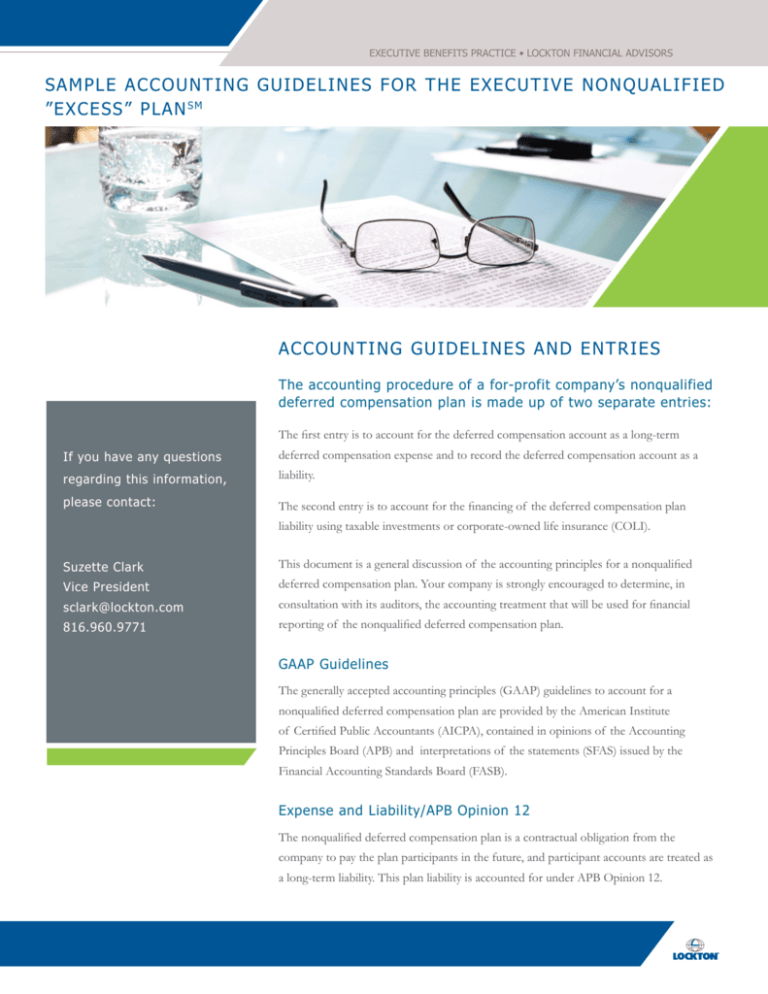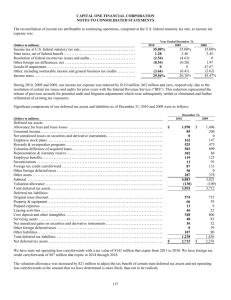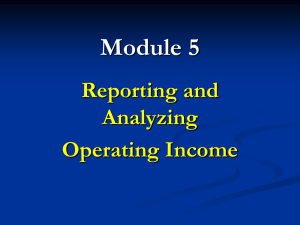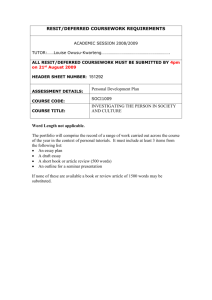
Executive Benefits Practice • LOCKTON Financial Advisors
SAMP LE AC COU N T IN G G U ID ELI NE S F OR T H E E XE C UT I VE NONQ UALIFIED
” Excess ” plan sm
A C C OUNT I NG GUI DE LI NE S A ND E NT RI ES
The accounting procedure of a for-profit company’s nonqualified
deferred compensation plan is made up of two separate entries:
The first entry is to account for the deferred compensation account as a long-term
If you have any questions
deferred compensation expense and to record the deferred compensation account as a
regarding this information,
liability.
please contact:
The second entry is to account for the financing of the deferred compensation plan
liability using taxable investments or corporate-owned life insurance (COLI).
Suzette Clark
This document is a general discussion of the accounting principles for a nonqualified
Vice President
deferred compensation plan. Your company is strongly encouraged to determine, in
sclark@lockton.com
consultation with its auditors, the accounting treatment that will be used for financial
816.960.9771
reporting of the nonqualified deferred compensation plan.
GAAP Guidelines
The generally accepted accounting principles (GAAP) guidelines to account for a
nonqualified deferred compensation plan are provided by the American Institute
of Certified Public Accountants (AICPA), contained in opinions of the Accounting
Principles Board (APB) and interpretations of the statements (SFAS) issued by the
Financial Accounting Standards Board (FASB).
Expense and Liability/APB Opinion 12
The nonqualified deferred compensation plan is a contractual obligation from the
company to pay the plan participants in the future, and participant accounts are treated as
a long-term liability. This plan liability is accounted for under APB Opinion 12.
Executive Benefits Practice • LOCKTON Financial Advisors
Corporate-Owned Taxable Investments/SFAS 159
If taxable investments are used to informally finance the nonqualified deferred compensation plan, the company may elect SFAS 159
entitled “The Fair Value Option for Financial Assets and Financial Liabilities” to account for these corporate assets. Under SFAS 159,
all realized and unrealized earnings are recognized currently on the income statement. Alternatively, companies may adopt SFAS 115,
“Accounting for Certain Investments in Debts and Equity Securities,” which may require that all unrealized gains (losses) be accounted
for as comprehensive income (a separate component of the stockholders’ equity). Please review SFAS 159 and SFAS 115 for additional
disclosure requirements and details.
Life Insurance/FASB Technical Bulletin No. 85-4
If corporate-owned life insurance is used to informally finance the nonqualified deferred compensation plan, FASB Technical Bulletin No.
85-4 entitled “Accounting for Purchases of Life Insurance” should be your reference. Also review EITF 06-5.
Income Taxes/SFAS 109
The plan liability is an expense that is deductible for tax purposes only when it is paid to the plan participant. The plan liability would
be grouped with all other deductibles temporary differences to compute the deferred tax asset. A deferred tax liability is recognized for
temporary differences that result in taxable amounts in future years. These deferred tax accounts are based on SFAS 109 guidance.
Expense and Liability (APB Opinion 12)
Expense and Liability Entries
Balance Sheet
DR
Income Statement
CR
DR
CR
1. Creating the Deferred Compensation Account
Cash
$100,000
Salary Expense
$100,000
Deferred Compensation Wage Expense
$100,000
Deferred Compensation Liability
$100,000
2. Crediting Earnings to the Deferred Compensation Account
Deferred Compensation Wage Expense
$8,000
Deferred Compensation Liability
$8,000
3. Distribute the Deferred Compensation Liability Account to the Plan
Participant and Close Out the Account
Deferred Compensation Liability
$108,000
Cash
$108,000
Tax Effects
1. Nondeductible Deferred Compensation Expense
Deferred Income Tax Asset
$40,000
Cash
$40,000
2. Nondeductible Effect of Earnings Credited
Deferred Income Tax Asset
$3,200
Tax Expense
$3,200
3. Deductible Distribution
Cash
Deferred Income Tax Asset
$43,200
$43,200
(1) The plan participant defers $100,000 of current compensation (or the company makes a corporate contribution), and the company sets up a Deferred Compensation Liability account and debits a Deferred Compensation Wage
Expense account. For plan participant deferrals, this does not create an additional expense for the company, because it would have paid the $100,000 in wages anyway. Since deferred compensation is not currently deductible for taxes,
the company owes an additional $40,000 ($100,000 x 40%) in current tax.
(2) Accounting for the earnings credited to the Deferred Compensation account, assuming a hypothetical 8 percent rate of return. This cost may be partially or fully offset by the earnings in an underlying asset used to informally
finance the plan. The company may book the tax effect of the increase in the deferred compensation account, but since it is not currently deductible it increases the deferred income tax asset.
(3) Paying out the plan participant with cash and closing out the Deferred Compensation Liability account. The payment is currently deductible for taxes, which reverses the deferred income tax asset.
Executive Benefits Practice • LOCKTON Financial Advisors
Accounting for Gains on Corporate-Owned Taxable Investments (FASB STMT #159)
Corporate Owned Taxable Investment Entries
Balance Sheet
DR
Income Statement
CR
DR
CR
1. Purchase of Mutual Fund(s) to Informally Finance Deferred Compensation
Liability Account
Mutual Fund(s)
$100,000
Cash
$100,000
2. Mutual Fund(s) Realized Earnings
Mutual Fund(s)
$5,000
Other Income
$5,000
3. Mutual Fund(s) Unrealized Earnings
Mutual Fund(s)
$3,000
Other Income
$3,000
4. Sell Mutual Fund(s) and Close Account
Cash
$108,000
Mutual Fund(s)
$108,000
Tax Effects
1. No Tax Effect
2. Tax Paid on Realized Earnings
Tax Expense
$2,000
Cash
$2,000
3. Tax Effect of Unrealized Earnings
Tax Expense
$1,200
Deferred Income Tax Liability
$1,200
4. Tax Paid on Realized Earnings
Deferred Income Tax Liability
Cash
$1,200
$1,200
(1) The company uses the plan participant’s $100,000 deferred wages (or company contribution) to open a mutual fund account. There is no tax effect.
(2) The mutual fund(s) increases $8,000 of which 25 percent ($2,000) was realized interest, dividend and capital gains distributions and of which 50 percent of the undistributed gains ($3,000) was realized capital gains due to
rebalancing. Realized gains are currently taxable to the company, resulting in additional tax of $2,000 paid ($5,000 x 40 percent).
(3) The mutual fund(s) increases $8,000 of which $3,000 was unrealized gain (increase in NAV). Unrealized gains are credited to current earnings. Unrealized gains create a deferred income tax liability, due to $1,200 in tax being owed
at a future time ($3,000 x 40 percent).
(4) The company sells the mutual fund(s) and deposits proceeds into cash. At this point, the company pays $1,200 in tax on the realized gains upon sale ($3,000 x 40 percent).
Executive Benefits Practice • LOCKTON Financial Advisors
Accounting for the Life Insurance Expense FASB Technical Bulletin 85-4 (Also See EITF 06-5)
Life Insurance Entries
Balance Sheet
(based on Executive Variable Universal Life Sample Model)
DR
Income Statement
CR
DR
CR
1. Company Pays Premium Into Insurance Contract
Life Insurance Premium Expense
$100,000
Cash
$100,000
2. Cash Surrender Value (CSV) in the Insurance Contract
Life Insurance CSV
$107,615
Life Insurance Premium Expense
$107,615
3. Partial Withdrawal of CSV (Surrender or Loan) and Deposit Into Cash
Cash
$10,000
Life Insurance CSV
$10,000
4. Plan Participant Dies at End of Year One With $1,000,000 of Death
Benefit
Cash
$902,385
Nontaxable Life Insurance Proceeds
$902,385
Cash
$97,615
Life Insurance CSV
$97,615
Tax Effects of Corporate Owned Life Insurance
1. No Tax Effect. Life Insurance Premiums Are Not Tax Deductible.
2. No Tax Effect. Withdrawal From a Life Insurance Policy is
Non-Taxable.
3. No Tax Effect. Proceeds from Death Benefits Are Nontaxable
(1) The company uses the plan participant’s deferred wages (or company contributions) and pays it as premium into the life insurance contract.
(2) The CSV is accounted for as an asset and offsets the life insurance premium expense.
(3) The company can withdraw money from the CSV in the form of a surrender or loan and deposit into company cash to pay a deferred compensation benefit to a plan participant.
(4) When the plan participant dies, the company receives the death benefit proceeds and recognizes the nontaxable income (the difference between the death benefit and the CSV).
Disclaimer: This communication is offered solely for discussion purposes. Lockton does not provide legal or tax advice. The services referenced are not a comprehensive list of all
necessary components for consideration. You are encouraged to seek qualified legal and tax counsel to assist in considering all the unique facts and circumstances. Additionally, this
communication is not intended to constitute U.S. federal tax advice, and is not intended or written to be used, and cannot be used, for the purpose of avoiding penalties under the
Internal Revenue Code or promoting, marketing, or recommending any transaction or matter addressed herein to another party.
This document contains proprietary work product of Lockton Financial Advisors, LLC, & Lockton Investment Advisors, LLC, and is provided on a confidential basis. Any reproduction,
disclosure or distribution to any third party without first securing written permission is expressly prohibited.
Securities offered through Lockton Financial Advisors, LLC, a registered broker-dealer and member FINRA, SIPC. For California, Lockton Financial Advisors, LLC, d.b.a. Lockton
Insurance Services, LLC, license number 0G13569
Reprinted with permission of the Principal Financial Group.
www.lockton.com
© 2013 Lockton, Inc. All rights reserved. Images © 2013 Thinkstock. All rights reserved.
g\executive benefits\flyers\12\sample accounting guidelines for the nonqualified dcp.indd\tlj\nfb
L
O
C
K
T
O
N
R
etirement
S
ervices





